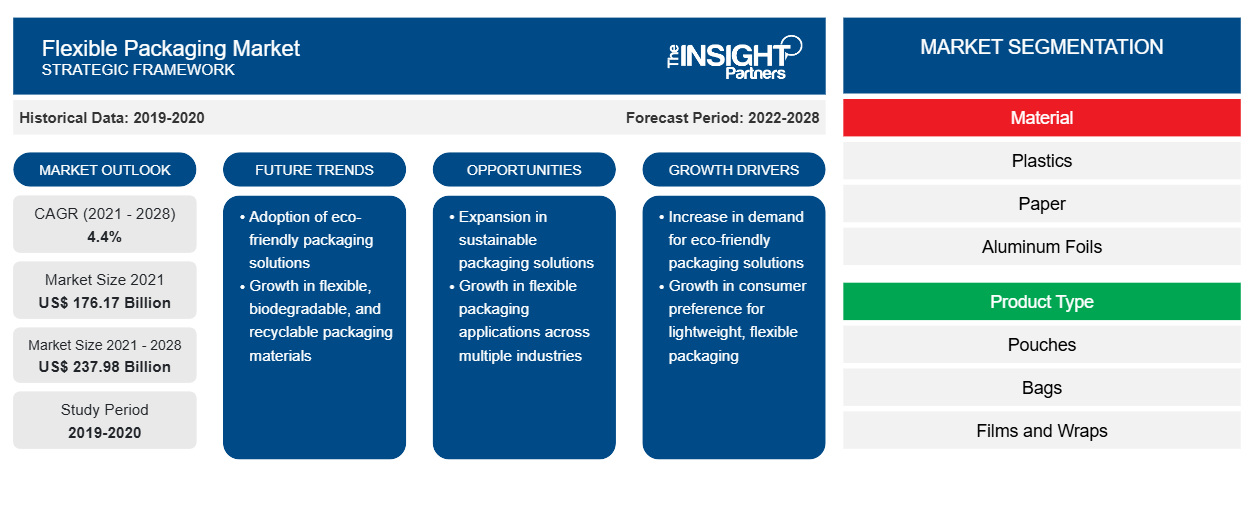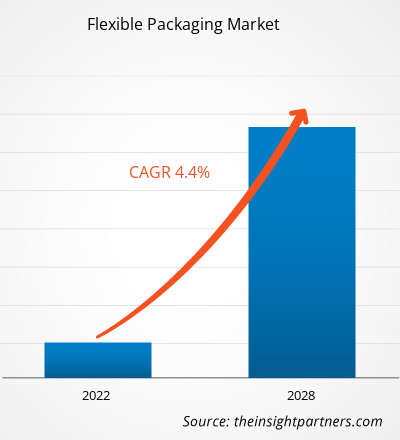フレキシブル包装市場は、2021年の176,173.61百万米ドルから2028年には237,975.67百万米ドルに達すると予測されており、2021年から2028年にかけて4.4%のCAGRで成長すると予想されています。
フレキシブル包装には、ライナー、ポーチ、シール、サンプル パケット、バッグが含まれます。フィルム、プラスチック、紙、ホイルなどで構成できます。さまざまな食品や飲料、消費者向け製品、音楽 CD、医薬品、コンピューター ソフトウェア パッケージ、栄養補助食品に使用されます。フレキシブル包装の耐久性により、メーカーは目を引く高品質のカスタム デザインを印刷でき、小売店での製品の視認性が向上します。
2020年、アジア太平洋地域は世界のフレキシブル包装市場で最大の収益シェアを占めました。アジア太平洋経済協力によると、オーストラリアはAPACの先進国の一つです。食品・飲料部門はオーストラリア最大の製造業であり、同国の製造業総売上高の32%を占めています。オーストラリア食品・食料品協議会の2019年業界レポートによると、食品・飲料、食料品、生鮮食品部門の価値は853.2億米ドルです。この業界は、273,000人以上を雇用するあらゆる規模の15,000の企業で構成されています。成長する食品・飲料業界がフレキシブル包装市場を牽引しています。
要件に合わせてレポートをカスタマイズする
このレポートの一部、国レベルの分析、Excelデータパックなど、あらゆるレポートを無料でカスタマイズできます。また、スタートアップや大学向けのお得なオファーや割引もご利用いただけます。
- このレポートの主要な市場動向を入手してください。この無料サンプルには、市場動向から見積もりや予測に至るまでのデータ分析が含まれます。
COVID-19パンデミックがフレキシブル包装市場に与える影響
製造ユニットの閉鎖、原材料の調達難、物流の制限は、フレキシブル包装市場に悪影響を及ぼしています。しかし、COVID-19により、オンライン食料品配達が大幅に増加しました。さらに、消費者が食料貯蔵庫の備蓄に殺到しているため、パッケージ食品および飲料業界では、乳製品を含む常温保存可能な食品や飲料の需要が急増しています。何百万もの世帯が、ピックアップまたは宅配のために食料品をオンラインで購入し始めており、危機が過ぎ去った後も、その多くがeコマースのオプションを使い続けるでしょう。さらに、一般的に貯蔵寿命を延ばすために高バリアの高級包装材料を使用する利便性重視の食品などの加工食品の需要の増加は、フレキシブル包装の必要性を促進する態勢が整っています。
市場分析
加工食品・飲料の消費増加
Anu Food Brazilのレポートによると、ブラジルの食品小売部門の総収益は2019年に960億米ドルでした。ブラジルの食品および飲料業界は、2019年に6.7%、2020年に12.8%の成長を達成しました。ブラジルでは冷凍食品市場が繁栄しています。ブラジルでは、中流階級の拡大、購買力の上昇、フルタイムで働く人の数の増加により、冷凍食品市場が繁栄しています。したがって、コンビニエンスフードに対する消費者の好みの高まりが、フレキシブル包装市場を牽引しています。Anu Food Brazil report, the Brazilian food retail sector’s total revenue was US$ 96 billion in 2019. The food & beverage industry in Brazil achieved growth of 6.7% in 2019 and 12.8% in 2020. The
素材産業の洞察
材料に基づいて、世界のフレキシブル包装市場は、プラスチック、紙、アルミホイル、その他に分類されます。プラスチックセグメントは、2020年に世界のフレキシブル包装市場で最大のシェアを占めました。フレキシブルプラスチック包装には、さまざまな製品の包装に使用されるさまざまな種類のプラスチック材料が含まれます。包装に使用される材料の種類は、包装される製品の用途と種類によって異なります。一般に、ポリエチレン、ポリプロピレン、ポリスチレン、ポリ塩化ビニルなどのプラスチック材料がフレキシブルプラスチック包装に使用されます。フレキシブル包装は、食品、飲料、医薬品、およびいくつかの消耗品を保存、配布、包装するための最も便利で経済的な方法と考えられています。
世界のフレキシブル包装市場で活動している主要企業としては、Amcor plc、Huhtamaki、Mondi、Berry Global Inc.、Sealed Air、Sonoco Products Company、Coveris、Constantia Flexibles、Flexpak services、Transcontinental Inc. などが挙げられます。この市場で活動している企業は、顧客の要件を満たす高品質で革新的な製品の開発に重点を置いています。
フレキシブル包装市場の地域別分析
予測期間を通じてフレキシブル包装市場に影響を与える地域的な傾向と要因は、Insight Partners のアナリストによって徹底的に説明されています。このセクションでは、北米、ヨーロッパ、アジア太平洋、中東、アフリカ、南米、中米にわたるフレキシブル包装市場のセグメントと地理についても説明します。

- フレキシブル包装市場の地域別データを入手
フレキシブル包装市場レポートの範囲
| レポート属性 | 詳細 |
|---|---|
| 2021年の市場規模 | 1,761.7億米ドル |
| 2028年までの市場規模 | 2,379.8億米ドル |
| 世界のCAGR(2021年~2028年) | 4.4% |
| 履歴データ | 2019-2020 |
| 予測期間 | 2022-2028 |
| 対象セグメント | 素材別
|
| 対象地域と国 | 北米
|
| 市場リーダーと主要企業プロフィール |
|
フレキシブル包装市場のプレーヤー密度:ビジネスダイナミクスへの影響を理解する
フレキシブル包装市場は、消費者の嗜好の変化、技術の進歩、製品の利点に対する認識の高まりなどの要因により、エンドユーザーの需要が高まり、急速に成長しています。需要が高まるにつれて、企業は提供品を拡大し、消費者のニーズを満たすために革新し、新たなトレンドを活用し、市場の成長をさらに促進しています。
市場プレーヤー密度とは、特定の市場または業界内で活動している企業または会社の分布を指します。これは、特定の市場スペースに、その市場規模または総市場価値に対してどれだけの競合相手 (市場プレーヤー) が存在するかを示します。
フレキシブル包装市場で事業を展開している主要企業は次のとおりです。
- アムコール
- フタマキ
- モンディ
- ベリーグローバル株式会社
- 密閉空気
免責事項:上記の企業は、特定の順序でランク付けされていません。

- フレキシブル包装市場のトップキープレーヤーの概要を入手
レポートの注目点
- フレキシブル包装業界の進歩的なトレンドは、プレーヤーが効果的な長期戦略を策定するのに役立ちます。
- 先進国と発展途上国の市場プレーヤーが採用しているビジネス成長戦略
- 2019年から2028年までのフレキシブル包装市場の定量分析
- フレキシブル包装の世界需要の推定
- 業界で活動するバイヤーとサプライヤーの有効性を示すポーターの5つの力の分析
- 競争市場の状況を理解するための最近の動向
- フレキシブル包装市場の成長を牽引・抑制する要因と市場動向および展望
- 商業的利益の基盤となる市場戦略を強調し、市場の成長につながる意思決定プロセスを支援する
- さまざまなノードにおけるフレキシブル包装市場の規模
- 市場の詳細な概要とセグメンテーション、および業界の動向
- 有望な成長機会のあるさまざまな地域のフレキシブル包装市場の規模
- 過去2年間の分析、基準年、CAGRによる予測(7年間)
- PEST分析とSWOT分析
- 市場規模価値/数量 - 世界、地域、国
- 業界と競争環境
- Excel データセット


- Sexual Wellness Market
- Semiconductor Metrology and Inspection Market
- Passport Reader Market
- Precast Concrete Market
- Medical Enzyme Technology Market
- Vaginal Specula Market
- Artwork Management Software Market
- Cell Line Development Market
- Biopharmaceutical Contract Manufacturing Market
- Saudi Arabia Drywall Panels Market

Report Coverage
Revenue forecast, Company Analysis, Industry landscape, Growth factors, and Trends

Segment Covered
This text is related
to segments covered.

Regional Scope
North America, Europe, Asia Pacific, Middle East & Africa, South & Central America

Country Scope
This text is related
to country scope.
よくある質問
The major players operating in the global flexible packaging market are Amcor plc; Huhtamaki; Mondi; Berry Global Inc.; Sealed Air; Sonoco Products Company; Coveris; Constantia Flexibles; Flexpak services; Transcontinental Inc.
In 2020, Asia-Pacific accounted for the largest share of the global flexible packaging market. The market for flexible packaging across Asia-Pacific has witnessed notable growth owing to the rapidly expanding packaging industry, growth of the food retail sector, and rising consumer awareness about sustainable packaging solutions across the region. The foodservice sector in Asia-Pacific is rapidly expanding owing to rapid economic growth, growth of the tourism sector, improving lifestyles of consumers, and rising disposable income levels. The region's food & beverage market is witnessing significant growth due to ample availability of various varieties of functional food and drinks and their growing demand among the millennial population. According to The Annual Report on Catering Industry Development of China 2019 (ARCIDC), China is the second-largest food and beverage economy across the world. The food and beverage revenue in China was over US$ 620 billion in 2018. The report further states that the online sales of food and beverages increased by US$ 44 billion from 2011 to 2017. Hence the growing demand for food & beverage in the region drives the flexible packaging market.
In 2020, the plastics segment accounted for the largest market share. Flexible plastic packaging delivers a wide range of protective properties while ensuring a minimum amount of material being used. It is made from high-grade polymers such as PVC, polyamide, polypropylene, and polyethylene. These polymers are FDA-approved and are contaminant-free. They can take on extreme temperatures and pressures. Furthermore, they also act as a protective layer for the food and beverage by protecting it from micro-organisms, UV rays, moisture, and dust.
The bags segment held the largest share of the market in 2020. These are commonly made of metal foil, plastic, and occasionally, paper. These bags are used in various packaging applications including food products, confectionery products, biscuits, coffee, powdered milk, snacks, etc. Also, these bags are easy for transport, material savings, and repeated use.
In 2020, Asia-Pacific is the fastest-growing region in the global flexible packaging market. According to Asia-Pacific Economic Cooperation, Australia is one of the developed countries in APAC. The food & beverage sector is Australia’s largest manufacturing industry, accounting for 32% of the country’s total manufacturing turnover. According to the Australian Food and Grocery Council’s 2019 State of the Industry Report, the food & beverage, grocery, and fresh produce sector is worth $122 billion. The industry is made up of 15,000 businesses of all sizes that employ over 273,000 people. The growing food & beverage industry drives the flexible packaging market.
The food and beverages segment held the largest share of the market in 2020. Flexible packaging is widely used for packaging food products such as eggs, fresh fruits and vegetables, and salad, among others. Flexible packaging protects products from moisture, UV rays, mold, dust, and other environmental contaminants that can negatively affect the product, thereby maintaining its quality and extending its shelf life. Also, with the growth of online food delivery channels the demand for flexible, affordable, and recyclable packaging is also on a rise.
Trends and growth analysis reports related to Chemicals and Materials : READ MORE..
The List of Companies - Flexible Packaging Market
- Amcor plc
- Huhtamaki
- Mondi
- Berry Global Inc.
- Sealed Air
- Sonoco Products Company
- Coveris
- Constantia Flexibles
- Flexpak services
- Transcontinental Inc.
The Insight Partners performs research in 4 major stages: Data Collection & Secondary Research, Primary Research, Data Analysis and Data Triangulation & Final Review.
- Data Collection and Secondary Research:
As a market research and consulting firm operating from a decade, we have published and advised several client across the globe. First step for any study will start with an assessment of currently available data and insights from existing reports. Further, historical and current market information is collected from Investor Presentations, Annual Reports, SEC Filings, etc., and other information related to company’s performance and market positioning are gathered from Paid Databases (Factiva, Hoovers, and Reuters) and various other publications available in public domain.
Several associations trade associates, technical forums, institutes, societies and organization are accessed to gain technical as well as market related insights through their publications such as research papers, blogs and press releases related to the studies are referred to get cues about the market. Further, white papers, journals, magazines, and other news articles published in last 3 years are scrutinized and analyzed to understand the current market trends.
- Primary Research:
The primarily interview analysis comprise of data obtained from industry participants interview and answers to survey questions gathered by in-house primary team.
For primary research, interviews are conducted with industry experts/CEOs/Marketing Managers/VPs/Subject Matter Experts from both demand and supply side to get a 360-degree view of the market. The primary team conducts several interviews based on the complexity of the markets to understand the various market trends and dynamics which makes research more credible and precise.
A typical research interview fulfils the following functions:
- Provides first-hand information on the market size, market trends, growth trends, competitive landscape, and outlook
- Validates and strengthens in-house secondary research findings
- Develops the analysis team’s expertise and market understanding
Primary research involves email interactions and telephone interviews for each market, category, segment, and sub-segment across geographies. The participants who typically take part in such a process include, but are not limited to:
- Industry participants: VPs, business development managers, market intelligence managers and national sales managers
- Outside experts: Valuation experts, research analysts and key opinion leaders specializing in the electronics and semiconductor industry.
Below is the breakup of our primary respondents by company, designation, and region:

Once we receive the confirmation from primary research sources or primary respondents, we finalize the base year market estimation and forecast the data as per the macroeconomic and microeconomic factors assessed during data collection.
- Data Analysis:
Once data is validated through both secondary as well as primary respondents, we finalize the market estimations by hypothesis formulation and factor analysis at regional and country level.
- Macro-Economic Factor Analysis:
We analyse macroeconomic indicators such the gross domestic product (GDP), increase in the demand for goods and services across industries, technological advancement, regional economic growth, governmental policies, the influence of COVID-19, PEST analysis, and other aspects. This analysis aids in setting benchmarks for various nations/regions and approximating market splits. Additionally, the general trend of the aforementioned components aid in determining the market's development possibilities.
- Country Level Data:
Various factors that are especially aligned to the country are taken into account to determine the market size for a certain area and country, including the presence of vendors, such as headquarters and offices, the country's GDP, demand patterns, and industry growth. To comprehend the market dynamics for the nation, a number of growth variables, inhibitors, application areas, and current market trends are researched. The aforementioned elements aid in determining the country's overall market's growth potential.
- Company Profile:
The “Table of Contents” is formulated by listing and analyzing more than 25 - 30 companies operating in the market ecosystem across geographies. However, we profile only 10 companies as a standard practice in our syndicate reports. These 10 companies comprise leading, emerging, and regional players. Nonetheless, our analysis is not restricted to the 10 listed companies, we also analyze other companies present in the market to develop a holistic view and understand the prevailing trends. The “Company Profiles” section in the report covers key facts, business description, products & services, financial information, SWOT analysis, and key developments. The financial information presented is extracted from the annual reports and official documents of the publicly listed companies. Upon collecting the information for the sections of respective companies, we verify them via various primary sources and then compile the data in respective company profiles. The company level information helps us in deriving the base number as well as in forecasting the market size.
- Developing Base Number:
Aggregation of sales statistics (2020-2022) and macro-economic factor, and other secondary and primary research insights are utilized to arrive at base number and related market shares for 2022. The data gaps are identified in this step and relevant market data is analyzed, collected from paid primary interviews or databases. On finalizing the base year market size, forecasts are developed on the basis of macro-economic, industry and market growth factors and company level analysis.
- Data Triangulation and Final Review:
The market findings and base year market size calculations are validated from supply as well as demand side. Demand side validations are based on macro-economic factor analysis and benchmarks for respective regions and countries. In case of supply side validations, revenues of major companies are estimated (in case not available) based on industry benchmark, approximate number of employees, product portfolio, and primary interviews revenues are gathered. Further revenue from target product/service segment is assessed to avoid overshooting of market statistics. In case of heavy deviations between supply and demand side values, all thes steps are repeated to achieve synchronization.
We follow an iterative model, wherein we share our research findings with Subject Matter Experts (SME’s) and Key Opinion Leaders (KOLs) until consensus view of the market is not formulated – this model negates any drastic deviation in the opinions of experts. Only validated and universally acceptable research findings are quoted in our reports.
We have important check points that we use to validate our research findings – which we call – data triangulation, where we validate the information, we generate from secondary sources with primary interviews and then we re-validate with our internal data bases and Subject matter experts. This comprehensive model enables us to deliver high quality, reliable data in shortest possible time.


 このレポートの無料サンプルを入手する
このレポートの無料サンプルを入手する